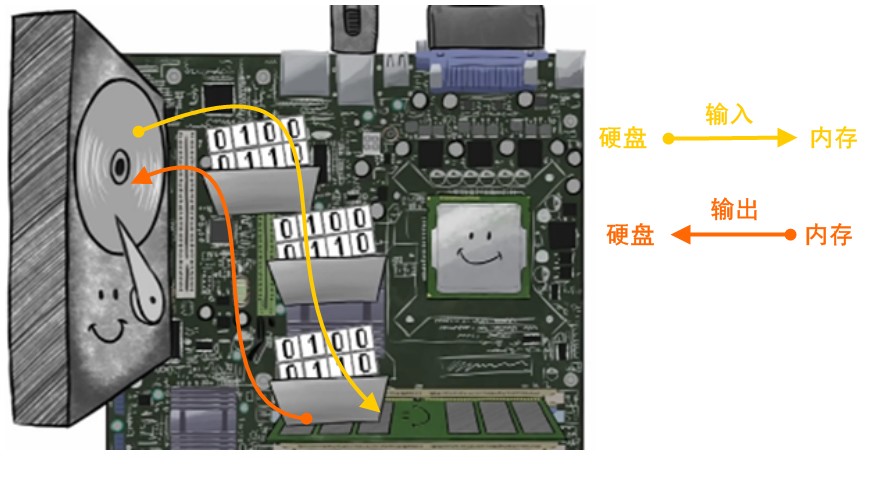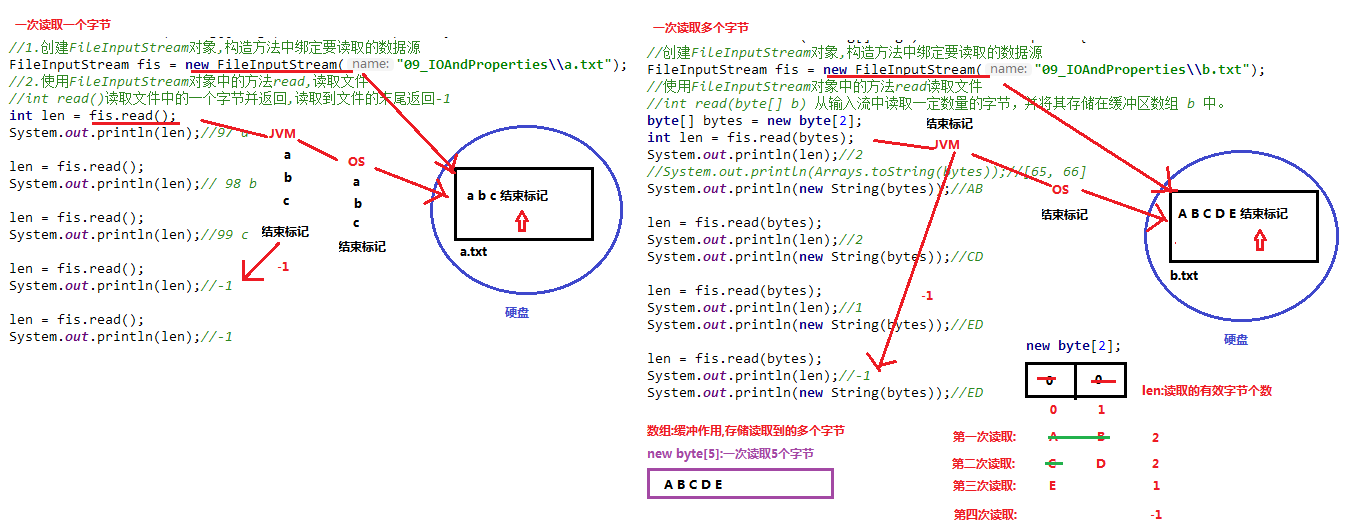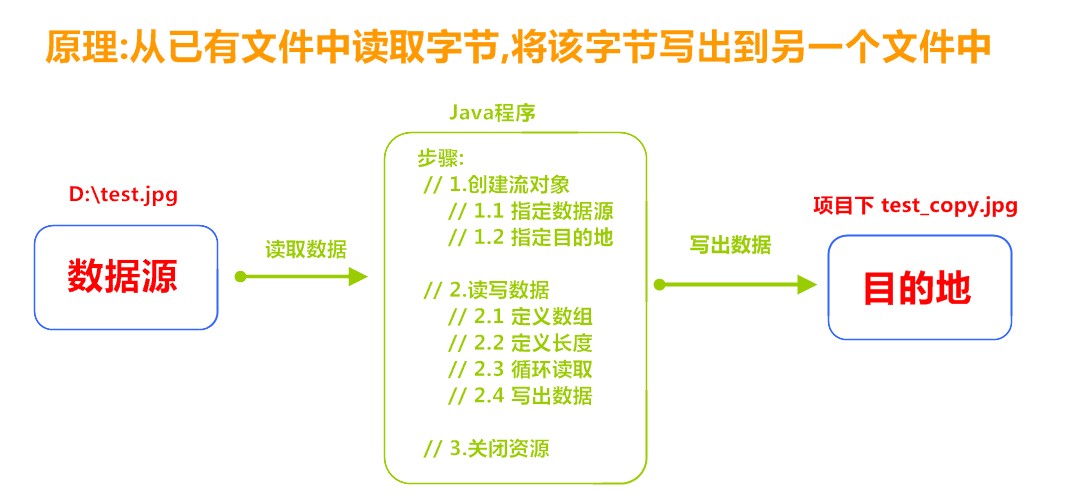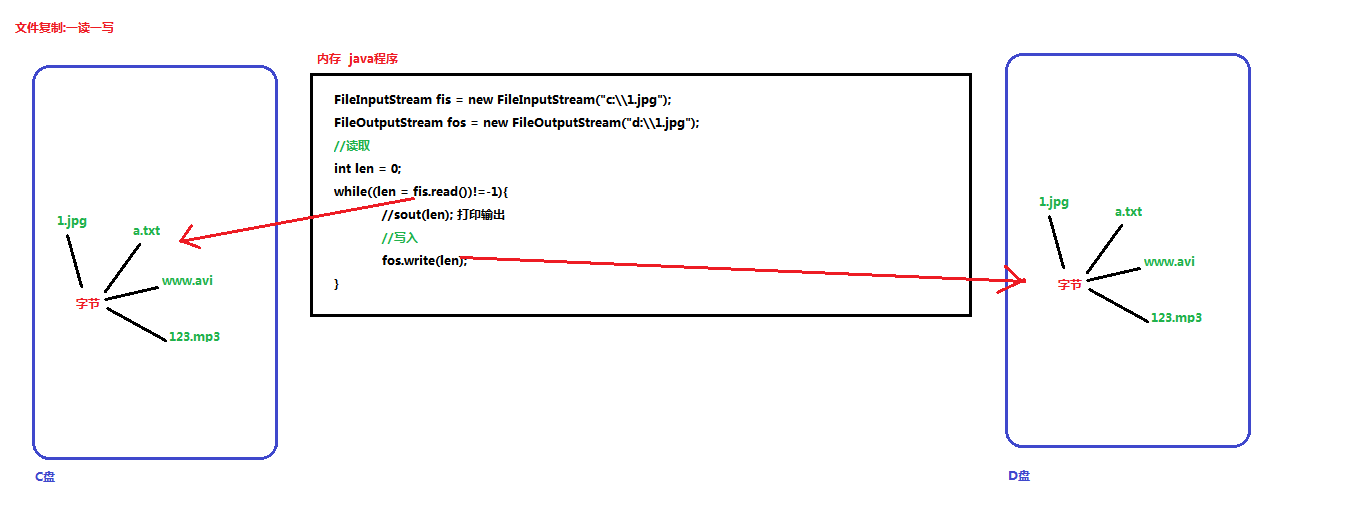字节流、字符流 主要内容
IO流
字节流
字符流
异常处理
Properties
教学目标
第一章 IO概述 1.1 什么是IO 生活中,你肯定经历过这样的场景。当你编辑一个文本文件,忘记了ctrl+s ,可能文件就白白编辑了。当你电脑上插入一个U盘,可以把一个视频,拷贝到你的电脑硬盘里。那么数据都是在哪些设备上的呢?键盘、内存、硬盘、外接设备等等。
我们把这种数据的传输,可以看做是一种数据的流动,按照流动的方向,以内存为基准,分为输入input 和输出output ,即流向内存是输入流,流出内存的输出流。
Java中I/O操作主要是指使用java.io包下的内容,进行输入、输出操作。输入 也叫做读取 数据,输出 也叫做作写出 数据。
1.2 IO的分类 根据数据的流向分为:输入流 和输出流 。
输入流 :把数据从其他设备上读取到内存中的流。 输出流 :把数据从内存 中写出到其他设备上的流。
格局数据的类型分为:字节流 和字符流 。
字节流 :以字节为单位,读写数据的流。字符流 :以字符为单位,读写数据的流。
1.3 IO的流向说明图解
1.4 顶级父类们
输入流 输出流
字节流 字节输入流InputStream
字节输出流OutputStream
字符流 字符输入流Reader
字符输出流Writer
第二章 字节流 2.1 一切皆为字节 一切文件数据(文本、图片、视频等)在存储时,都是以二进制数字的形式保存,都一个一个的字节,那么传输时一样如此。所以,字节流可以传输任意文件数据。在操作流的时候,我们要时刻明确,无论使用什么样的流对象,底层传输的始终为二进制数据。
2.2 字节输出流【OutputStream】 java.io.OutputStream 抽象类是表示字节输出流的所有类的超类,将指定的字节信息写出到目的地。它定义了字节输出流的基本共性功能方法。
public void close() :关闭此输出流并释放与此流相关联的任何系统资源。 public void flush() :刷新此输出流并强制任何缓冲的输出字节被写出。 public void write(byte[] b):将 b.length字节从指定的字节数组写入此输出流。 public void write(byte[] b, int off, int len) :从指定的字节数组写入 len字节,从偏移量 off开始输出到此输出流。 public abstract void write(int b) :将指定的字节输出流。
小贴士:
close方法,当完成流的操作时,必须调用此方法,释放系统资源。
2.3 FileOutputStream类 OutputStream有很多子类,我们从最简单的一个子类开始。
java.io.FileOutputStream 类是文件输出流,用于将数据写出到文件。
构造方法
public FileOutputStream(File file):创建文件输出流以写入由指定的 File对象表示的文件。 public FileOutputStream(String name): 创建文件输出流以指定的名称写入文件。
当你创建一个流对象时,必须传入一个文件路径。该路径下,如果没有这个文件,会创建该文件。如果有这个文件,会清空这个文件的数据。
1 2 3 4 5 6 7 8 9 10 public class FileOutputStreamConstructor throws IOException public static void main (String[] args) File file = new File("a.txt" ); FileOutputStream fos = new FileOutputStream(file); FileOutputStream fos = new FileOutputStream("b.txt" ); } }
写出字节数据
写出字节 :write(int b) 方法,每次可以写出一个字节数据,代码使用演示:
1 2 3 4 5 6 7 8 9 10 11 12 13 14 public class FOSWrite public static void main (String[] args) throws IOException FileOutputStream fos = new FileOutputStream("fos.txt" ); fos.write(97 ); fos.write(98 ); fos.write(99 ); fos.close(); } } 输出结果: abc
小贴士:
虽然参数为int类型四个字节,但是只会保留一个字节的信息写出。
流操作完毕后,必须释放系统资源,调用close方法,千万记得。
demo in class
1 2 3 4 5 6 7 8 9 10 11 12 13 14 15 16 17 18 19 20 21 22 23 24 25 26 27 28 29 30 31 32 33 34 35 36 37 38 39 40 41 42 43 44 45 46 47 48 49 50 package com.itheima.demo01.OutputStream;import java.io.FileOutputStream;import java.io.IOException;public class Demo01OutputStream public static void main (String[] args) throws IOException FileOutputStream fos = new FileOutputStream("09_IOAndProperties\\a.txt" ); fos.write(97 ); } }
写出字节数组 :write(byte[] b),每次可以写出数组中的数据,代码使用演示:
1 2 3 4 5 6 7 8 9 10 11 12 13 14 public class FOSWrite public static void main (String[] args) throws IOException FileOutputStream fos = new FileOutputStream("fos.txt" ); byte [] b = "黑马程序员" .getBytes(); fos.write(b); fos.close(); } } 输出结果: 黑马程序员
写出指定长度字节数组 :write(byte[] b, int off, int len) ,每次写出从off索引开始,len个字节,代码使用演示:
1 2 3 4 5 6 7 8 9 10 11 12 13 14 public class FOSWrite public static void main (String[] args) throws IOException FileOutputStream fos = new FileOutputStream("fos.txt" ); byte [] b = "abcde" .getBytes(); fos.write(b,2 ,2 ); fos.close(); } } 输出结果: cd
demo in class
1 2 3 4 5 6 7 8 9 10 11 12 13 14 15 16 17 18 19 20 21 22 23 24 25 26 27 28 29 30 31 32 33 34 35 36 37 38 39 40 41 42 43 44 45 46 47 48 49 50 51 package com.itheima.demo01.OutputStream;import java.io.File;import java.io.FileOutputStream;import java.io.IOException;import java.util.Arrays;public class Demo02OutputStream public static void main (String[] args) throws IOException FileOutputStream fos = new FileOutputStream(new File("09_IOAndProperties\\b.txt" )); fos.write(49 ); fos.write(48 ); fos.write(48 ); byte [] bytes = {65 ,66 ,67 ,68 ,69 }; fos.write(bytes); fos.write(bytes,1 ,2 ); byte [] bytes2 = "你好" .getBytes(); System.out.println(Arrays.toString(bytes2)); fos.write(bytes2); fos.close(); } }
数据追加续写 经过以上的演示,每次程序运行,创建输出流对象,都会清空目标文件中的数据。如何保留目标文件中数据,还能继续添加新数据呢?
public FileOutputStream(File file, boolean append): 创建文件输出流以写入由指定的 File对象表示的文件。 public FileOutputStream(String name, boolean append): 创建文件输出流以指定的名称写入文件。
这两个构造方法,参数中都需要传入一个boolean类型的值,true 表示追加数据,false 表示清空原有数据。这样创建的输出流对象,就可以指定是否追加续写了,代码使用演示:
1 2 3 4 5 6 7 8 9 10 11 12 13 14 public class FOSWrite public static void main (String[] args) throws IOException FileOutputStream fos = new FileOutputStream("fos.txt" ,true ); byte [] b = "abcde" .getBytes(); fos.write(b); fos.close(); } } 文件操作前:cd 文件操作后:cdabcde
1 2 3 4 5 6 7 8 9 10 11 12 13 14 15 16 17 18 19 20 21 22 23 24 25 26 27 28 29 30 package com.itheima.demo01.OutputStream;import java.io.FileOutputStream;import java.io.IOException;public class Demo03OutputStream public static void main (String[] args) throws IOException FileOutputStream fos = new FileOutputStream("09_IOAndProperties\\c.txt" ,true ); for (int i = 1 ; i <=10 ; i++) { fos.write("你好" .getBytes()); fos.write("\r\n" .getBytes()); } fos.close(); } }
写出换行 Windows系统里,换行符号是\r\n 。把
以指定是否追加续写了,代码使用演示:
1 2 3 4 5 6 7 8 9 10 11 12 13 14 15 16 17 18 19 20 21 22 23 24 public class FOSWrite public static void main (String[] args) throws IOException FileOutputStream fos = new FileOutputStream("fos.txt" ); byte [] words = {97 ,98 ,99 ,100 ,101 }; for (int i = 0 ; i < words.length; i++) { fos.write(words[i]); fos.write("\r\n" .getBytes()); } fos.close(); } } 输出结果: a b c d e
回车符\r和换行符\n :
回车符:回到一行的开头(return)。
换行符:下一行(newline)。
系统中的换行:
Windows系统里,每行结尾是 回车+换行 ,即\r\n;
Unix系统里,每行结尾只有 换行 ,即\n;
Mac系统里,每行结尾是 回车 ,即\r。从 Mac OS X开始与Linux统一。
java.io.InputStream 抽象类是表示字节输入流的所有类的超类,可以读取字节信息到内存中。它定义了字节输入流的基本共性功能方法。
public void close() :关闭此输入流并释放与此流相关联的任何系统资源。 public abstract int read(): 从输入流读取数据的下一个字节。 public int read(byte[] b): 从输入流中读取一些字节数,并将它们存储到字节数组 b中 。
小贴士:
close方法,当完成流的操作时,必须调用此方法,释放系统资源。
java.io.FileInputStream 类是文件输入流,从文件中读取字节。
构造方法
FileInputStream(File file): 通过打开与实际文件的连接来创建一个 FileInputStream ,该文件由文件系统中的 File对象 file命名。 FileInputStream(String name): 通过打开与实际文件的连接来创建一个 FileInputStream ,该文件由文件系统中的路径名 name命名。
当你创建一个流对象时,必须传入一个文件路径。该路径下,如果没有该文件,会抛出FileNotFoundException 。
1 2 3 4 5 6 7 8 9 10 public class FileInputStreamConstructor throws IOException public static void main (String[] args) File file = new File("a.txt" ); FileInputStream fos = new FileInputStream(file); FileInputStream fos = new FileInputStream("b.txt" ); } }
读取字节数据
读取字节 :read方法,每次可以读取一个字节的数据,提升为int类型,读取到文件末尾,返回-1,代码使用演示:
1 2 3 4 5 6 7 8 9 10 11 12 13 14 15 16 17 18 19 20 21 22 23 24 25 26 27 28 29 public class FISRead public static void main (String[] args) throws IOException FileInputStream fis = new FileInputStream("read.txt" ); int read = fis.read(); System.out.println((char ) read); read = fis.read(); System.out.println((char ) read); read = fis.read(); System.out.println((char ) read); read = fis.read(); System.out.println((char ) read); read = fis.read(); System.out.println((char ) read); read = fis.read(); System.out.println( read); fis.close(); } } 输出结果: a b c d e -1
循环改进读取方式,代码使用演示:
1 2 3 4 5 6 7 8 9 10 11 12 13 14 15 16 17 18 19 20 public class FISRead public static void main (String[] args) throws IOException FileInputStream fis = new FileInputStream("read.txt" ); int b ; while ((b = fis.read())!=-1 ) { System.out.println((char )b); } fis.close(); } } 输出结果: a b c d e
小贴士:
虽然读取了一个字节,但是会自动提升为int类型。
流操作完毕后,必须释放系统资源,调用close方法,千万记得。
demo in class
1 2 3 4 5 6 7 8 9 10 11 12 13 14 15 16 17 18 19 20 21 22 23 24 25 26 27 28 29 30 31 32 33 34 35 36 37 38 39 40 41 42 43 44 45 46 47 48 49 50 51 52 53 54 55 56 57 58 59 60 61 62 63 64 65 66 67 68 69 70 71 72 73 74 75 76 package com.itheima.demo02.InputStream;import java.io.FileInputStream;import java.io.IOException;public class Demo01InputStream public static void main (String[] args) throws IOException FileInputStream fis = new FileInputStream("09_IOAndProperties\\c.txt" ); int len = 0 ; while ((len = fis.read())!=-1 ){ System.out.print(len); } fis.close(); } }
使用字节数组读取 :read(byte[] b),每次读取b的长度个字节到数组中,返回读取到的有效字节个数,读取到末尾时,返回-1 ,代码使用演示:
1 2 3 4 5 6 7 8 9 10 11 12 13 14 15 16 17 18 19 20 21 22 public class FISRead public static void main (String[] args) throws IOException FileInputStream fis = new FileInputStream("read.txt" ); int len ; byte [] b = new byte [2 ]; while (( len= fis.read(b))!=-1 ) { System.out.println(new String(b)); } fis.close(); } } 输出结果: ab cd ed
错误数据d,是由于最后一次读取时,只读取一个字节e,数组中,上次读取的数据没有被完全替换,所以要通过len ,获取有效的字节,代码使用演示:
1 2 3 4 5 6 7 8 9 10 11 12 13 14 15 16 17 18 19 20 21 22 public class FISRead public static void main (String[] args) throws IOException FileInputStream fis = new FileInputStream("read.txt" ); int len ; byte [] b = new byte [2 ]; while (( len= fis.read(b))!=-1 ) { System.out.println(new String(b,0 ,len)); } fis.close(); } } 输出结果: ab cd e
小贴士:
使用数组读取,每次读取多个字节,减少了系统间的IO操作次数,从而提高了读写的效率,建议开发中使用。
1 2 3 4 5 6 7 8 9 10 11 12 13 14 15 16 17 18 19 20 21 22 23 24 25 26 27 28 29 30 31 32 33 34 35 36 37 38 39 40 41 42 43 44 45 46 47 48 49 50 51 52 53 54 55 56 57 58 59 package com.itheima.demo02.InputStream;import java.io.FileInputStream;import java.io.IOException;public class Demo02InputStream public static void main (String[] args) throws IOException FileInputStream fis = new FileInputStream("09_IOAndProperties\\b.txt" ); byte [] bytes = new byte [1024 ]; int len = 0 ; while ((len = fis.read(bytes))!=-1 ){ System.out.println(new String(bytes,0 ,len)); } fis.close(); } }
2.6 字节流练习:图片复制 复制原理图解
案例实现 复制图片文件,代码使用演示:
1 2 3 4 5 6 7 8 9 10 11 12 13 14 15 16 17 18 19 20 21 22 23 24 public class Copy public static void main (String[] args) throws IOException FileInputStream fis = new FileInputStream("D:\\test.jpg" ); FileOutputStream fos = new FileOutputStream("test_copy.jpg" ); byte [] b = new byte [1024 ]; int len; while ((len = fis.read(b))!=-1 ) { fos.write(b, 0 , len); } fos.close(); fis.close(); } }
小贴士:
流的关闭原则:先开后关,后开先关。
demo in class
1 2 3 4 5 6 7 8 9 10 11 12 13 14 15 16 17 18 19 20 21 22 23 24 25 26 27 28 29 30 31 32 33 34 35 36 37 38 39 40 41 42 43 44 45 46 47 48 49 50 51 52 package com.itheima.demo03.CopyFile;import java.io.FileInputStream;import java.io.FileOutputStream;import java.io.IOException;public class Demo01CopyFile public static void main (String[] args) throws IOException long s = System.currentTimeMillis(); FileInputStream fis = new FileInputStream("c:\\1.jpg" ); FileOutputStream fos = new FileOutputStream("d:\\1.jpg" ); byte [] bytes = new byte [1024 ]; int len = 0 ; while ((len = fis.read(bytes))!=-1 ){ fos.write(bytes,0 ,len); } fos.close(); fis.close(); long e = System.currentTimeMillis(); System.out.println("复制文件共耗时:" +(e-s)+"毫秒" ); } }
第三章 字符流 当使用字节流读取文本文件时,可能会有一个小问题。就是遇到中文字符时,可能不会显示完整的字符,那是因为一个中文字符可能占用多个字节存储。所以Java提供一些字符流类,以字符为单位读写数据,专门用于处理文本文件。
3.1 字符输入流【Reader】 java.io.Reader抽象类是表示用于读取字符流的所有类的超类,可以读取字符信息到内存中。它定义了字符输入流的基本共性功能方法。
public void close() :关闭此流并释放与此流相关联的任何系统资源。 public int read(): 从输入流读取一个字符。 public int read(char[] cbuf): 从输入流中读取一些字符,并将它们存储到字符数组 cbuf中 。
3.2 FileReader类 java.io.FileReader 类是读取字符文件的便利类。构造时使用系统默认的字符编码和默认字节缓冲区。
小贴士:
字符编码:字节与字符的对应规则。Windows系统的中文编码默认是GBK编码表。
idea中UTF-8
字节缓冲区:一个字节数组,用来临时存储字节数据。
构造方法
FileReader(File file): 创建一个新的 FileReader ,给定要读取的File对象。 FileReader(String fileName): 创建一个新的 FileReader ,给定要读取的文件的名称。
当你创建一个流对象时,必须传入一个文件路径。类似于FileInputStream 。
1 2 3 4 5 6 7 8 9 10 public class FileReaderConstructor throws IOException public static void main (String[] args) File file = new File("a.txt" ); FileReader fr = new FileReader(file); FileReader fr = new FileReader("b.txt" ); } }
读取字符数据
读取字符 :read方法,每次可以读取一个字符的数据,提升为int类型,读取到文件末尾,返回-1,循环读取,代码使用演示:
1 2 3 4 5 6 7 8 9 10 11 12 13 14 15 16 17 18 19 20 public class FRRead public static void main (String[] args) throws IOException FileReader fr = new FileReader("read.txt" ); int b ; while ((b = fr.read())!=-1 ) { System.out.println((char )b); } fr.close(); } } 输出结果: 黑 马 程 序 员
小贴士:虽然读取了一个字符,但是会自动提升为int类型。
使用字符数组读取 :read(char[] cbuf),每次读取b的长度个字符到数组中,返回读取到的有效字符个数,读取到末尾时,返回-1 ,代码使用演示:
1 2 3 4 5 6 7 8 9 10 11 12 13 14 15 16 17 18 19 20 public class FRRead public static void main (String[] args) throws IOException FileReader fr = new FileReader("read.txt" ); int len ; char [] cbuf = new char [2 ]; while ((len = fr.read(cbuf))!=-1 ) { System.out.println(new String(cbuf)); } fr.close(); } } 输出结果: 黑马 程序 员序
获取有效的字符改进,代码使用演示:
1 2 3 4 5 6 7 8 9 10 11 12 13 14 15 16 17 18 19 20 21 public class FISRead public static void main (String[] args) throws IOException FileReader fr = new FileReader("read.txt" ); int len ; char [] cbuf = new char [2 ]; while ((len = fr.read(cbuf))!=-1 ) { System.out.println(new String(cbuf,0 ,len)); } fr.close(); } } 输出结果: 黑马 程序 员
demo in class
1 2 3 4 5 6 7 8 9 10 11 12 13 14 15 16 17 18 19 20 21 22 23 24 25 26 27 28 29 30 31 32 33 34 35 36 37 38 39 40 41 42 43 44 45 46 47 48 49 50 51 52 53 54 55 56 57 58 package com.itheima.Demo04.Reader;import java.io.FileReader;import java.io.IOException;public class Demo02Reader public static void main (String[] args) throws IOException FileReader fr = new FileReader("09_IOAndProperties\\c.txt" ); char [] cs = new char [1024 ]; int len = 0 ; while ((len = fr.read(cs))!=-1 ){ System.out.println(new String(cs,0 ,len)); } fr.close(); } }
3.3 字符输出流【Writer】 java.io.Writer 抽象类是表示用于写出字符流的所有类的超类,将指定的字符信息写出到目的地。它定义了字节输出流的基本共性功能方法。
void write(int c) 写入单个字符。void write(char[] cbuf) 写入字符数组。 abstract void write(char[] cbuf, int off, int len) 写入字符数组的某一部分,off数组的开始索引,len写的字符个数。 void write(String str) 写入字符串。 void write(String str, int off, int len) 写入字符串的某一部分,off字符串的开始索引,len写的字符个数。void flush() 刷新该流的缓冲。 void close() 关闭此流,但要先刷新它。
3.4 FileWriter类 java.io.FileWriter 类是写出字符到文件的便利类。构造时使用系统默认的字符编码和默认字节缓冲区。
构造方法
FileWriter(File file): 创建一个新的 FileWriter,给定要读取的File对象。 FileWriter(String fileName): 创建一个新的 FileWriter,给定要读取的文件的名称。
当你创建一个流对象时,必须传入一个文件路径,类似于FileOutputStream。
1 2 3 4 5 6 7 8 9 10 public class FileWriterConstructor public static void main (String[] args) throws IOException File file = new File("a.txt" ); FileWriter fw = new FileWriter(file); FileWriter fw = new FileWriter("b.txt" ); } }
基本写出数据 写出字符 :write(int b) 方法,每次可以写出一个字符数据,代码使用演示:
1 2 3 4 5 6 7 8 9 10 11 12 13 14 15 16 17 18 19 public class FWWrite public static void main (String[] args) throws IOException FileWriter fw = new FileWriter("fw.txt" ); fw.write(97 ); fw.write('b' ); fw.write('C' ); fw.write(30000 ); } } 输出结果: abC田
小贴士:
虽然参数为int类型四个字节,但是只会保留一个字符的信息写出。
未调用close方法,数据只是保存到了缓冲区,并未写出到文件中。
demo in class
1 2 3 4 5 6 7 8 9 10 11 12 13 14 15 16 17 18 19 20 21 22 23 24 25 26 27 28 29 30 31 32 33 34 35 36 37 38 39 40 41 42 43 44 45 46 47 48 49 50 51 package com.itheima.Demo05Writer;import java.io.FileWriter;import java.io.IOException;public class Demo01Writer public static void main (String[] args) throws IOException FileWriter fw = new FileWriter("09_IOAndProperties\\d.txt" ); fw.write(97 ); fw.close(); } }
关闭和刷新 因为内置缓冲区的原因,如果不关闭输出流,无法写出字符到文件中。但是关闭的流对象,是无法继续写出数据的。如果我们既想写出数据,又想继续使用流,就需要flush 方法了。
flush :刷新缓冲区,流对象可以继续使用。close :先刷新缓冲区,然后通知系统释放资源。流对象不可以再被使用了。
代码使用演示:
1 2 3 4 5 6 7 8 9 10 11 12 13 14 15 16 17 public class FWWrite public static void main (String[] args) throws IOException FileWriter fw = new FileWriter("fw.txt" ); fw.write('刷' ); fw.flush(); fw.write('新' ); fw.flush(); fw.write('关' ); fw.close(); fw.write('闭' ); fw.close(); } }
小贴士:即便是flush方法写出了数据,操作的最后还是要调用close方法,释放系统资源。
demo in class
1 2 3 4 5 6 7 8 9 10 11 12 13 14 15 16 17 18 19 20 21 22 23 24 25 26 27 28 29 package com.itheima.Demo05Writer;import java.io.FileWriter;import java.io.IOException;public class Demo02CloseAndFlush public static void main (String[] args) throws IOException FileWriter fw = new FileWriter("09_IOAndProperties\\e.txt" ); fw.write(97 ); fw.flush(); fw.write(98 ); fw.close(); fw.write(99 ); } }
写出其他数据
写出字符数组 :write(char[] cbuf) 和 write(char[] cbuf, int off, int len) ,每次可以写出字符数组中的数据,用法类似FileOutputStream,代码使用演示:
1 2 3 4 5 6 7 8 9 10 11 12 13 14 15 16 17 public class FWWrite public static void main (String[] args) throws IOException FileWriter fw = new FileWriter("fw.txt" ); char [] chars = "黑马程序员" .toCharArray(); fw.write(chars); fw.write(b,2 ,2 ); fos.close(); } }
写出字符串 :write(String str) 和 write(String str, int off, int len) ,每次可以写出字符串中的数据,更为方便,代码使用演示:
1 2 3 4 5 6 7 8 9 10 11 12 13 14 15 16 17 public class FWWrite public static void main (String[] args) throws IOException FileWriter fw = new FileWriter("fw.txt" ); String msg = "黑马程序员" ; fw.write(msg); fw.write(msg,2 ,2 ); fos.close(); } }
demo in class
1 2 3 4 5 6 7 8 9 10 11 12 13 14 15 16 17 18 19 20 21 22 23 24 25 26 27 28 29 30 31 package com.itheima.Demo05Writer;import java.io.FileWriter;import java.io.IOException;public class Demo03Writer public static void main (String[] args) throws IOException FileWriter fw = new FileWriter("09_IOAndProperties\\f.txt" ); char [] cs = {'a' ,'b' ,'c' ,'d' ,'e' }; fw.write(cs); fw.write(cs,1 ,3 ); fw.write("传智播客" ); fw.write("黑马程序员" ,2 ,3 ); fw.close(); } }
续写和换行 :操作类似于FileOutputStream。
1 2 3 4 5 6 7 8 9 10 11 12 13 14 15 16 17 public class FWWrite public static void main (String[] args) throws IOException FileWriter fw = new FileWriter("fw.txt" ,true ); fw.write("黑马" ); fw.write("\r\n" ); fw.write("程序员" ); fw.close(); } } 输出结果: 黑马 程序员
小贴士:字符流,只能操作文本文件,不能操作图片,视频等非文本文件。
当我们单纯读或者写文本文件时 使用字符流 其他情况使用字节流
demo in class
1 2 3 4 5 6 7 8 9 10 11 12 13 14 15 16 17 18 19 20 21 22 23 24 25 26 27 28 package com.itheima.Demo05Writer;import java.io.FileWriter;import java.io.IOException;public class Demo04Writer public static void main (String[] args) throws IOException FileWriter fw = new FileWriter("09_IOAndProperties\\g.txt" ,true ); for (int i = 0 ; i <10 ; i++) { fw.write("HelloWorld" +i+"\r\n" ); } fw.close(); } }
第四章 IO异常的处理 JDK7前处理 之前的入门练习,我们一直把异常抛出,而实际开发中并不能这样处理,建议使用try...catch...finally 代码块,处理异常部分,代码使用演示:
1 2 3 4 5 6 7 8 9 10 11 12 13 14 15 16 17 18 19 20 21 22 public class HandleException1 public static void main (String[] args) FileWriter fw = null ; try { fw = new FileWriter("fw.txt" ); fw.write("黑马程序员" ); } catch (IOException e) { e.printStackTrace(); } finally { try { if (fw != null ) { fw.close(); } } catch (IOException e) { e.printStackTrace(); } } } }
demo in class
1 2 3 4 5 6 7 8 9 10 11 12 13 14 15 16 17 18 19 20 21 22 23 24 25 26 27 28 29 30 31 32 33 34 35 36 37 38 39 40 41 42 43 44 45 46 47 package com.itheima.demo06.trycatch;import java.io.FileWriter;import java.io.IOException;public class Demo01TryCatch public static void main (String[] args) FileWriter fw = null ; try { fw = new FileWriter("w:\\09_IOAndProperties\\g.txt" ,true ); for (int i = 0 ; i <10 ; i++) { fw.write("HelloWorld" +i+"\r\n" ); } }catch (IOException e){ System.out.println(e); }finally { if (fw!=null ){ try { fw.close(); } catch (IOException e) { e.printStackTrace(); } } } } }
JDK7的处理(扩展知识点了解内容) 还可以使用JDK7优化后的try-with-resource 语句,该语句确保了每个资源在语句结束时关闭。所谓的资源(resource)是指在程序完成后,必须关闭的对象。
格式:
1 2 3 4 5 try (创建流对象语句,如果多个,使用';' 隔开) { } catch (IOException e) { e.printStackTrace(); }
代码使用演示:
1 2 3 4 5 6 7 8 9 10 11 public class HandleException2 public static void main (String[] args) try ( FileWriter fw = new FileWriter("fw.txt" ); ) { fw.write("黑马程序员" ); } catch (IOException e) { e.printStackTrace(); } } }
demo in class
1 2 3 4 5 6 7 8 9 10 11 12 13 14 15 16 17 18 19 20 21 22 23 24 25 26 27 28 29 30 31 32 33 34 35 36 37 38 39 40 41 42 package com.itheima.demo06.trycatch;import java.io.FileInputStream;import java.io.FileOutputStream;import java.io.IOException;public class Demo02JDK7 public static void main (String[] args) try ( FileInputStream fis = new FileInputStream("c:\\1.jpg" ); FileOutputStream fos = new FileOutputStream("d:\\1.jpg" );){ int len = 0 ; while ((len = fis.read())!=-1 ){ fos.write(len); } }catch (IOException e){ System.out.println(e); } } }
JDK9的改进(扩展知识点了解内容) JDK9中try-with-resource 的改进,对于引入对象 的方式,支持的更加简洁。被引入的对象,同样可以自动关闭,无需手动close,我们来了解一下格式。
改进前格式:
1 2 3 4 5 6 7 8 9 final Resource resource1 = new Resource("resource1" );Resource resource2 = new Resource("resource2" ); try (Resource r1 = resource1; Resource r2 = resource2) { }
改进后格式:
1 2 3 4 5 6 7 8 9 final Resource resource1 = new Resource("resource1" );Resource resource2 = new Resource("resource2" ); try (resource1; resource2) { }
改进后,代码使用演示:
1 2 3 4 5 6 7 8 9 10 11 12 13 14 15 16 17 18 19 public class TryDemo public static void main (String[] args) throws IOException final FileReader fr = new FileReader("in.txt" ); FileWriter fw = new FileWriter("out.txt" ); try (fr; fw) { int b; while ((b = fr.read())!=-1 ) { fw.write(b); } } catch (IOException e) { e.printStackTrace(); } } }
第五章 属性集 5.1 概述 java.util.Properties 继承于 Hashtable ,来表示一个持久的属性集。它使用键值结构存储数据,每个键及其对应值都是一个字符串。该类也被许多Java类使用,比如获取系统属性时,System.getProperties 方法就是返回一个Properties对象。
5.2 Properties类 构造方法
public Properties() :创建一个空的属性列表。
基本的存储方法
public Object setProperty(String key, String value) : 保存一对属性。 public String getProperty(String key) :使用此属性列表中指定的键搜索属性值。public Set<String> stringPropertyNames() :所有键的名称的集合。
1 2 3 4 5 6 7 8 9 10 11 12 13 14 15 16 17 18 19 20 21 22 23 24 25 26 27 28 29 30 31 public class ProDemo public static void main (String[] args) throws FileNotFoundException Properties properties = new Properties(); properties.setProperty("filename" , "a.txt" ); properties.setProperty("length" , "209385038" ); properties.setProperty("location" , "D:\\a.txt" ); System.out.println(properties); System.out.println(properties.getProperty("filename" )); System.out.println(properties.getProperty("length" )); System.out.println(properties.getProperty("location" )); Set<String> strings = properties.stringPropertyNames(); for (String key : strings ) { System.out.println(key+" -- " +properties.getProperty(key)); } } } 输出结果: {filename=a.txt, length=209385038 , location=D:\a.txt} a.txt 209385038 D:\a.txt filename -- a.txt length -- 209385038 location -- D:\a.txt
与流相关的方法
public void load(InputStream inStream): 从字节输入流中读取键值对。
参数中使用了字节输入流,通过流对象,可以关联到某文件上,这样就能够加载文本中的数据了。文本数据格式:
1 2 3 filename=a.txt length=209385038 location=D:\a.txt
加载代码演示:
1 2 3 4 5 6 7 8 9 10 11 12 13 14 15 16 17 public class ProDemo2 public static void main (String[] args) throws FileNotFoundException Properties pro = new Properties(); pro.load(new FileInputStream("read.txt" )); Set<String> strings = pro.stringPropertyNames(); for (String key : strings ) { System.out.println(key+" -- " +pro.getProperty(key)); } } } 输出结果: filename -- a.txt length -- 209385038 location -- D:\a.txt
小贴士:文本中的数据,必须是键值对形式,可以使用空格、等号、冒号等符号分隔。
demo in class
1 2 3 4 5 6 7 8 9 10 11 12 13 14 15 16 17 18 19 20 21 22 23 24 25 26 27 28 29 30 31 32 33 34 35 36 37 38 39 40 41 42 43 44 45 46 47 48 49 50 51 52 53 54 55 56 57 58 59 60 61 62 63 64 65 66 67 68 69 70 71 72 73 74 75 76 77 78 79 80 81 82 83 84 85 86 87 88 89 90 91 92 93 94 95 96 97 98 99 100 101 102 103 104 105 106 107 108 109 110 111 112 113 114 115 116 117 package com.itheima.demo07.Prop;import java.io.FileOutputStream;import java.io.FileReader;import java.io.IOException;import java.util.Properties;import java.util.Set;public class Demo01Properties public static void main (String[] args) throws IOException show03(); } private static void show03 () throws IOException Properties prop = new Properties(); prop.load(new FileReader("09_IOAndProperties\\prop.txt" )); Set<String> set = prop.stringPropertyNames(); for (String key : set) { String value = prop.getProperty(key); System.out.println(key+"=" +value); } } private static void show02 () throws IOException Properties prop = new Properties(); prop.setProperty("赵丽颖" ,"168" ); prop.setProperty("迪丽热巴" ,"165" ); prop.setProperty("古力娜扎" ,"160" ); prop.store(new FileOutputStream("09_IOAndProperties\\prop2.txt" ),"" ); } private static void show01 () Properties prop = new Properties(); prop.setProperty("赵丽颖" ,"168" ); prop.setProperty("迪丽热巴" ,"165" ); prop.setProperty("古力娜扎" ,"160" ); Set<String> set = prop.stringPropertyNames(); for (String key : set) { String value = prop.getProperty(key); System.out.println(key+"=" +value); } } }




